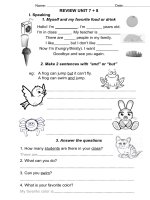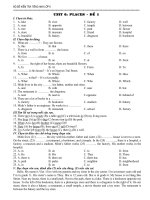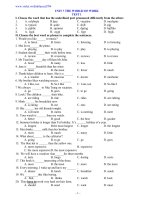Enterprise 1 Unit 7 and 8
Bạn đang xem bản rút gọn của tài liệu. Xem và tải ngay bản đầy đủ của tài liệu tại đây (301.69 KB, 18 trang )
<span class='text_page_counter'>(1)</span>UNIT 7+ 8 / BÀI 7 + 8. 1.
<span class='text_page_counter'>(2)</span> . Thì quá khứ đơn giản . Cách sử dụng Dấu hiệu nhận biết Công thức . Be Can Normal Verb / ĐT thường. 2.
<span class='text_page_counter'>(3)</span> . Cách sử dụng: . Chỉ hành động, sự việc đã xảy ra và kết thúc trong quá khứ, biết rõ thời gian (hôm qua, tuần trước,...) I lived in New York last year. She started work when she was 8.. . Dùng để mô tả hàng loạt hành động, sự việc xảy ra liên tiếp trong quá khứ Yesterday, I got up late. So I had breakfast quickly, then I went to school by bus. The bus was late. Therefore I went to my office late. My boss was very angry. 3.
<span class='text_page_counter'>(4)</span> . Dấu hiệu nhận biết / Từ chỉ thời gian . . . . . Đứng đầu hoặc cuối câu I lived in New York last year. She started work when she was 8. (2 days) + ago = last + (2 days) : trước đây 2 days ago = last 2 days; one month ago = last month; few weeks ago = last few weeks Yesterday; Yesterday + morning/ afternoon / evening (hôm qua, sáng qua, chiều qua, tối qua) When + S + was/were + .... + young/ small/ a child / a little girl / 15 years old ... (Khi ......... còn trẻ/ còn nhỏ/là một đứa trẻ/ lên 15 tuổi ..) On + Sept. 2nd 1945 (+ ngày) In + 1954 / August 1980 (+ tháng / năm/ thế kỷ/ thiên niên kỷ) 4.
<span class='text_page_counter'>(5)</span> . Công thức . Be → was; were Can → could Normal Verb / ĐT thường: V(inf.) + ed. 5.
<span class='text_page_counter'>(6)</span> . . Công thức của ‘to be’ (+) S + was / were + ... I, she, he, it, DT số ít + was You, we, they, DT số nhiều + were VD: I was 18 in 1998. Her friends were at home yesterday. Ms. Hoa was in Boston in 2006. My mother was a worker. 6.
<span class='text_page_counter'>(7)</span> . Công thức của ‘to be’ (-) S + was / were + not + ... (was not = wasn’t; were not = weren’t). . VD: I was not 18 in 1998. Her friends weren’t at home yesterday. Ms. Hoa wasn’t in Boston in 2006. My mother wasn’t a worker. 7.
<span class='text_page_counter'>(8)</span> . Công thức của ‘to be’ (?) Was / Were + S + ...? Yes, S + was /were. No, S + wasn’t/weren’t.. (Chủ ngữ trong câu trả lời phải là 1 trong 7 ĐTNX: I, you, we, they, she, he, it). I was 18 in 1998. → Were you 18 in 1998? Yes, I was. Her friends were at home yesterday. → Were her friends at home yesterday? No, they weren’t. Ms. Hoa was in Boston in 2006. → Was Ms. Hoa in Boston in 2006? No, she wasn’t. My mother was a worker. → Was your mother a worker? Yes, she was. . 8.
<span class='text_page_counter'>(9)</span> THÌ QUÁ KHỨ ĐƠN GIẢN . . . Công thức của ‘to be’ (?) Wh_ + was/ were + S + …? Where were you last night? (I was) at the pub (last night). When were you born? (I was born) in TN. Where was your husband at midnight yesterday? (He was) at work / in his office. When was your baby born? (She was born) on May 23rd 2008. 9.
<span class='text_page_counter'>(10)</span> . . Công thức của ‘can’ → could (+) S + could + V(inf.) (-) S + could + not + V(inf.) (?) Could + S + V(inf.)? Yes, S could. (No, S couldn’t) I could swim when I was 10 years old. She could run very well. My mother could not cook when she was 6. Could you sing a song when you were 5? Yes, I could. Could he play football? No, he couldn’t.. 10.
<span class='text_page_counter'>(11)</span> THÌ QUÁ KHỨ ĐƠN GIẢN . Công thức của ‘can’ → could Nói về khả năng của một người, vật. (biết làm gì trong. quá khứ) . . My mother could not cook when she was 6. Could you sing a song when you were 5? Yes, I could.. Ở dạng câu hỏi còn là cách đưa ra lời đề nghị lịch sự (không mang nghĩa là quá khứ, mà là hiện tại, không phải câu hỏi dù có hình thức giống câu hỏi, mà mang tính lịch sự). . . Could you help me? (Can you help me?) Làm ơn giúp tôi. Could you give me some money, mother? (Can you give ….?) Mẹ ơi cho con ít tiền. Could you tell me the way to the post office? (Can you tell me…?) Làm ơn chỉ cho tôi đường đến bưu điện.. 11.
<span class='text_page_counter'>(12)</span> THÌ QUÁ KHỨ ĐƠN GIẢN Công thức với NV/ ĐT thường (+) S + V+ed + ... Tận cùng ĐT là 1 e +d: dance → danced (# agree → agreed) Tận cùng ĐT là 1 nguyên âm + 1 phụ âm: stop →stopped Tận cùng ĐT là 1 phụ âm +y: cry → cried (# play →played; fly → flew) ĐT bất quy tắc: go →went; run →run; cut →cut . 12.
<span class='text_page_counter'>(13)</span> THÌ QUÁ KHỨ ĐƠN GIẢN . . . Công thức với NV/ ĐT thường (+) S + V+ed + ... I lived in New York last year. She stopped the presentation. (ngừng bài trình bày) The child cried when she was hungry. (Đứa trẻ khóc khi nó đói) They cut a lot of trees last year. (Năm ngoái họ chặt rất nhiều cây) 13.
<span class='text_page_counter'>(14)</span> THÌ QUÁ KHỨ ĐƠN GIẢN Công thức với NV/ ĐT thường Cách phát âm của đuôi ‘ed’ thêm vào sau các ĐT có quy tắc ‘ed’ /t/ nếu tận cùng của ĐT là c, f, k, p, x, s, sh, ch watched; laughed; stopped; looked; wished; ‘ed’ /id/ nếu tận cùng của ĐT là d, t wanted; needed; decided ‘ed’ /d/ với các trường hợp còn lại (phổ biến nhất) loved; died; married; opened; . 14.
<span class='text_page_counter'>(15)</span> THÌ QUÁ KHỨ ĐƠN GIẢN . . Công thức với NV/ ĐT thường (-) S + did not + V(inf.) + … ‘did’ là trợ động từ, ở thì quá khứ đơn giản, không có nghĩa, chỉ xuất hiện ở dạng (-) và (?) V(inf.): ĐT nguyên thể không có ‘to” (nguyên dạng như trong từ điển). Nguyên tắc “vay gì trả nấy” I lived in New York last year. I did not live in New York. She stopped the presentation. She did not stop the presentation. The child cried when she was hungry. The child did not cry when she was hungry. They cut a lot of trees last year. They did not cut a lot of trees last year. . 15.
<span class='text_page_counter'>(16)</span> THÌ QUÁ KHỨ ĐƠN GIẢN . Công thức với NV/ ĐT thường (?) Did + S + V(inf.) + …? Yes, S did. (No, S didn’t).. Chủ ngữ trong câu trả lời với Yes, No phải là 1 trong 7 ĐTNX Nguyên tắc “vay gì trả nấy” I lived in New York last year. Did you live in New York last year? Yes, I did. She stopped the presentation. Did she stop the presentation? No, she didn’t. The child cried when she was hungry. Did the child cry when she was hungry? Yes, she did. They cut a lot of trees last year. Did they cut a lot of trees last year? Yes, they did. . 16.
<span class='text_page_counter'>(17)</span> THÌ QUÁ KHỨ ĐƠN GIẢN . Công thức với NV/ ĐT thường (?) Wh_ + did + S + V(inf.)?. Nguyên tắc “vay gì trả nấy” I lived in New York last year. When did you live in New York? Where did you live last year? The child cried when she was hungry. When did the child cry? They cut a lot of trees last year. When did they cut a lot of trees? What did they cut last year? What did they do last year? . 17.
<span class='text_page_counter'>(18)</span> TÓM TẮT NỘI DUNG . Thì quá khứ đơn giản . . Cách sử dụng: xảy ra trong quá khứ (thời gian cụ thể) Dấu hiệu nhận biết: last, ago, yesterday Công thức . Be: was, were Can: could + V(inf) Normal Verb / ĐT thường: . V + ed; did not + V(inf). Nguyên tắc “vay gì trả nấy” với dạng phủ định và nghi vấn 18.
<span class='text_page_counter'>(19)</span>









